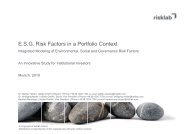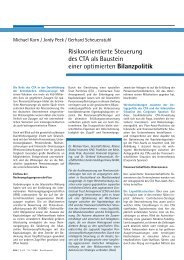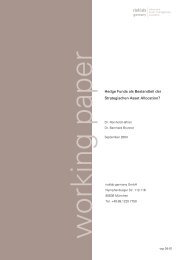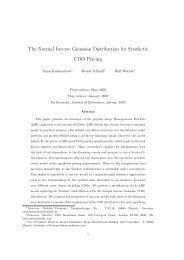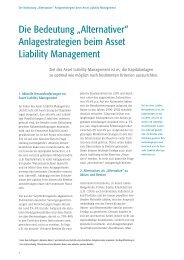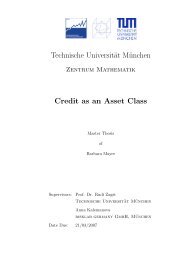Technical University Munich Commodities as an Asset Class - risklab
Technical University Munich Commodities as an Asset Class - risklab
Technical University Munich Commodities as an Asset Class - risklab
You also want an ePaper? Increase the reach of your titles
YUMPU automatically turns print PDFs into web optimized ePapers that Google loves.
2.1 The different Commodity Types<br />
world’s dem<strong>an</strong>d for cocoa is negatively correlated to inflation by -0.2. 28 Production<br />
depends on the number <strong>an</strong>d characteristics of the ever green tropic cocoa trees<br />
pl<strong>an</strong>ted 5 to 6 years ago what results in <strong>an</strong> inability to react to unexpected short<br />
term dem<strong>an</strong>d. 29 An other unstable factor in this market is the political situation<br />
of the major producing countries. Cote d’Ivories h<strong>as</strong> just ce<strong>as</strong>ed its civil war but<br />
still, there are political queries what cause a production decre<strong>as</strong>e. In 2007 the cocoa<br />
market is likely be nervous because Africa h<strong>as</strong> to fight against a cocoa moth plague.<br />
2.1.3.2 Grains exemplified by Corn<br />
Corn is a member of the gr<strong>as</strong>s family of pl<strong>an</strong>ts <strong>an</strong>d is a native grain of the Americ<strong>an</strong><br />
continent. About 5,000 BC, it w<strong>as</strong> first cultivated in Central America to use it <strong>as</strong><br />
hum<strong>an</strong> food. The cereal w<strong>as</strong> brought to Europe <strong>an</strong>d North America, but remained<br />
poorly grown until the 19th century. Corn is a resist<strong>an</strong>t pl<strong>an</strong>t only vulnerable to early<br />
frosts in fall that c<strong>an</strong> be grown in different climates r<strong>an</strong>ging from arid to tropical<br />
<strong>an</strong>d in different regions r<strong>an</strong>ging from flat country to mountain side. Today, corn<br />
accounts for about 70% of the world coarse grain trade <strong>an</strong>d about 75% of its yearly<br />
production are used for <strong>an</strong>imal feed. 30 A small amount of around 15% is still used<br />
in hum<strong>an</strong> food mainly for oil <strong>an</strong>d vegetari<strong>an</strong> food <strong>an</strong>d the remaining percentages are<br />
used for alcohol distilleries <strong>an</strong>d the production of eth<strong>an</strong>ol for engines. Latter part<br />
of usage is expected to incre<strong>as</strong>e considerably caused by the high oil prices. Today<br />
around 95% of North America’s eth<strong>an</strong>ol is made from corn. Programs on eth<strong>an</strong>ol<br />
production from corn will therefore have a const<strong>an</strong>t influence on corn prices in the<br />
future. 31<br />
By far the biggest producer worldwide is the USA with around 40% of share of total<br />
world production in 2006. 32 It reached its production high so far in 2004 with a<br />
total output of 300 million tonnes, i.e. 80 million tonnes (= 25%) more th<strong>an</strong> in<br />
2006. Figure 2.12 shows the worldwide development of inventory, production <strong>an</strong>d<br />
consumption <strong>an</strong>d the equivalent year ending prices. 33<br />
Low prices since the end of the 90s have made corn business unattractive <strong>an</strong>d<br />
Figure 2.12 clearly shows that inventories have fallen since then. Calculating the<br />
28 Thus, it c<strong>an</strong> be <strong>as</strong>sumed that a decline in prices of 10% results in <strong>an</strong> incre<strong>as</strong>e in dem<strong>an</strong>d of 2%.<br />
29 A single tree c<strong>an</strong> produce 20 fruits but it needs 400 to get one pound of chocolate.<br />
30 See [The CRB Commodity Yearbook 2005].<br />
31 See [USDA Grain 2006].<br />
32 Moreover, the USA is the biggest exporter worldwide with around 70% of share of world corn<br />
trade showing world’s corn supply dependence of US production output.<br />
33 See [USDA Grain 2006] <strong>an</strong>d [The CRB Commodity Yearbook 2005].<br />
25



